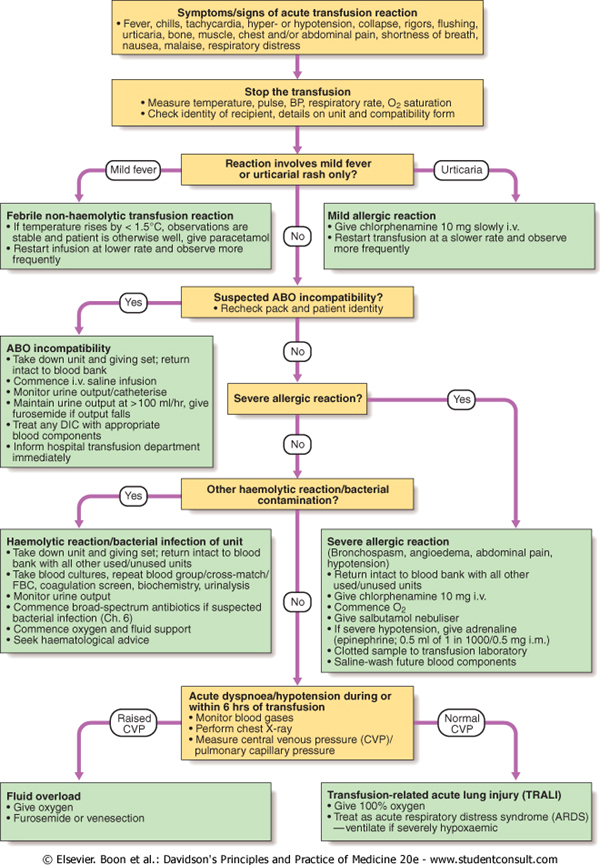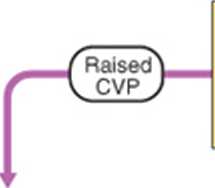F00574 024 f017


Mild fever
Symptoms/signs of acute transfusion reaction
• Fever, chills. tachycardia. hyper- or hypotension. collapse, rigors. flushmg, urticaria, bonę. musde. chest and/or abdominal pain, shortness of breath, nausea. malaise. respiratory distress
Stop the transfusion
• Measure temperaturę, pulse. BP. respiratory ratę. O2 saturation
• Check identity of recipient. details on unit and compatibiiity form
Urticaria

Reaction involves mild fever or urticarial rash only?
|
Fcbrile non-haomolytic transfusion reaction |
Mild allergic roaction | |
|
• if temperaturo nses by < 1.5CC. observations are |
© |
• Give chlorphenamine 10 mg slowly i.v. |
|
stable and patient is otherwise woli, give paracetamoi • Restart infusion at lower ratę and observe morę |
• Restart transfusion at a siower ratę and observe morę freguently | |
|
freguently |

Suspcctcd ABO incompatibility?
• Recheck pack and patient identity
ABO incompatibility
• Take down unit and giving set; return mtact to blood bank
• Commence i.v. salinę infusion
• Monitor urine output/catheterise
• Maintam urine output at > 100 ml/hr. give furosemide if output falls
• Treat any OIC with appropriate blood components
• Inform hospital transfusion department immediately
No
|
Scvcrc allergic reaction? | ||
No

Othcr hacmolytic rcaction/bactcrial contamination?
Haemolytic reaction/bacterial infection of unit
• Take down unit and giving set; return mtact to blood bank with all other used''unused units
• Take blood cultures. repeat blood group/cross-match/ FBC. coagulation screen. błochemistry. urinalysis
• Monitor urine output
• Commence broad-spectrum antibiotics if suspected bacterial infection (Ch. 6)
• Commence oxygen and fluid support
• Seek haematological advice
©
Severe allergic reaction
(Bronchospasm. angioedema. abdominal pain. hypotension)
• Return iniact to blood bank with all other used/unused units
• Give chlorphenamine 10 mg i.v.
• Commence O2
• Give salbutamol nebuliser
• If severe hypotension. give adrenalinę (epinephrine; 0.5 ml of 1 in 1000/0.5 mg i.m.)
• Clotted sample to transfusion laboraiory
• Saline-wash futurę blood components

Acute dyspnooa/hypotcnsion during or within 6 hrs of transfusion
• Monitor blood gases
• Perform chest X-ray
• Measure central venous pressure (CVP)/ pulmonary capillary pressure

|
Fluid ovorload |
Transfusion-related acute lung injury (TRALI) | |
|
• Give oxygen |
• Give 100% oxygen | |
|
• Furosemide or venesection |
• Treat as acute respiratory distress syndrome (ARDS) —veniilate if severely hypoxaemic |
© Elsevier. Boon et al.: Davidson's Principles and Practice of Medicine 20e - www.studentconsult.com
Wyszukiwarka
Podobne podstrony:
F00574 024 g002 o ANAEMIA The box shows the symptoms and signs that will help to indicate the d
F00574 013 g001 Scalp Temporal artery tenderness Metastases Optic fundi Roths spots Haemorrhage
F00574 024 f006 Neutrophil Causes of neutrophilia Causes of
F00574 024 f022a [AjDirect antiglobulin test (DAT) (Coombs test) Detects the presence of antibody bo
F00574 024 f032b © Elsevier. Boon et al.: Davidson’s Principles and Practice of Medłcine 20e - www.s
F00574 004 f008 Headache Confusion Anorexia Low blood pressure Liver: t Synthesis of acute phase pro
F00574 006 f017 ^Anaerobic QGram-positive
F00574 018 f017 Stable angina Unstable angina Pathophysiology Clinical features Risk assessment •
F00574 019 g002 ©-© KEY FEATURES ON EXAMINATION OF COMMON RESPIRATORY CONDITIONSChronić obstructive
F00574 022 f041 Oxalate calculi Increased absorption of oxalate Decreased bile salt pool, lith
F00574 024 f003 Myeloblast Promyelocyte Myelocyte— Metamyelocyte Red bloocf Neutrophil celi Early
F00574 024 f004 Glycophorin C Band 3Membranę - 40% lipid - 50% p
F00574 024 f012 MCV normal (76-98 fl) or low (< 76 fl)T Blood film and reticulocyte countl High r
F00574 024 f016 00PO Test for: HIV HTLV Hepatitis B Hepatitis C Syphilis ABO + R
F00574 024 f025 Pulmonary Sickle chest syndrome Infection Osteomyelitis Ocular Background retinopath
F00574 024 f033 Amyloid Panda eyes Nephrotic syndrome Carpai tunnel syndrome Bonę pain/fractur
F00574 024 g001 Conjunctiva Pallor Jaundice AFundal haemorrhage k Fundi Haemorrtiage Hyperviscosity&
F00574 024 i004 JłJ
45738 P1130048 Fig. 1.95: Oasct of embryonic mortality on Day 17 of gesta-tion. Signs of abnormality
więcej podobnych podstron